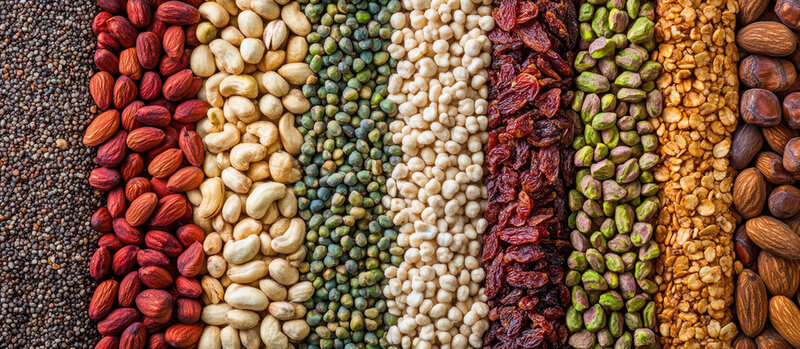KEYWORDS
Bakery
Fibre
Reformulation
Abstract
As consumer interest shifts from high-protein hype to holistic gut health, fibre is re-emerging as a key - but underutilised - driver of food innovation. This article explores how ingredient suppliers and manufacturers can capitalise on fibre's role as a nutritional and functional powerhouse that offers brands not only sensory and textural benefits but also positions fibre for its critical role in contributing to overall health and wellness . With many products already near claim thresholds and retailers setting bold fibre targets, the opportunity for stealth-health reformulation has never been greater. The piece positions fibre as a low-disruption, high-impact solution for brands seeking to enhance their wellness credentials without compromising texture, taste, or shelf appeal.
As nutritional science evolves, the focus has shifted inward, towards the gut. Consumers, increasingly sceptical of overhyped trends, particularly in the crowded high-protein space, are seeking ingredients with real, research-backed benefits that can promote microbiome health. Among the rising stars in this new era of functional nutrition is fibre, which has long been dismissed as an afterthought but is now taking centre stage as a cornerstone of holistic health and food innovation.
Backed by decades of scientific research and renewed interest in microbiomes and gut health, fibre is reshaping consumer expectations and product development strategies alike. It's no longer just about fibre as a digestive aid, but a foundational nutrient for wellness, functionality and flavour. (1)

A compelling argument
Fibre’s resurgence is underpinned by compelling evidence. A comprehensive meta-analysis published in The Lancet linked high dietary intake to a 15 to 30% reduction in risk of death and chronic diseases, including coronary heart disease, stroke and type 2 diabetes. (2)
At the same time, nearly two-thirds of global consumers now consider digestive health a central part of their overall wellness goals. This shift in consumer mindset is driving a transformation in the food industry. Fibre-enriched products - from fortified cereals to fibre-rich functional beverages - are no longer niche. (3) They are becoming the norm, ushering in a new era where gut health is not just a trend, but a foundation of modern wellness.
This trend is further evidences by the number of fibre-rich launches, particularly in the bakery aisle. An independent audit conducted by the ACI Group and German-based supplier of fibre ingredients, GoodMills Innovation, regarding the hundreds of product launches in the bakery and desserts category between January 2021 and April 2025 shows some significant insights.
The results indicate that while protein continues to dominate on-pack claims, fibre has marginally outpaced it in product launches, with 194 Source of Fibre or High Fibre launches compared to 183 protein launches over the past five years. However, the survey also showed that budget retailers and their baked goods suppliers are lagging in embracing communication around growth, showcasing a real commercial opportunity that is being missed.
Fibre - more than a digestive aid
While fibre has historically been seen as a single-purpose ingredient, it is now being recognised as a multifunctional asset in innovative food and product formulations. For suppliers and manufacturers, its versatility opens doors to innovation, differentiation, and deeper consumer trust. (4)
Dietary fibres bring a wide array of functional benefits to the table: emulsification, water holding, gel formation, thickening, fat replacement and more. They are cost-effective, making them particularly attractive in today’s margin-sensitive environment.
On the health side, fibres can support digestive wellness, weight management and metabolic health. As a prebiotic, fibre can promote beneficial gut bacteria to support a healthy microbiome and immune function. (5) Their role in appetite regulation and insulin response further underscores their systemic impact on wellness. This narrative means that fibre is no longer viewed simply as a good-for-you addition to a product, but as a strategic component in formulations that can enhance taste, texture and product quality.
The science behind the shift
And emerging research is continuing to expand fibre’s functional repertoire. Certain fibres not only help with sugar and fat reduction but also improve mouthfeel, enhance moisture retention and extend shelf life.
Take chicory root fibre (inulin) and resistant dextrin or starches. These soluble fibres are far more than bulking agents. They offer sweetness modulation and texture enhancement and are ideal for applications in dairy alternatives and gluten-free baked goods - categories where sensory performance is critical. (6)
For ingredient suppliers, this creates a unique opportunity to engage with brands on fibre as a nutritional powerhouse, while highlighting its functionality advantage. For formulators, it’s a chance to meet clean label demands, improve nutritional profiles and elevate the eating experience - all without sacrificing performance.
Fibre also comes with a very compelling sustainability story. Sourced from ingredients like chicory, oats, barley, and citrus, many fibres are derived from natural and upcycled sources and minimally processed – delivering on both ecological and consumer expectations.
Functionality meets innovation
Fibre’s dual value, physiological and technological, is gaining traction across food systems. Soluble fibres such asinulin, fructooligosaccharides (FOS) and polydextrose are especially useful in formulating reduced-sugar products. They deliver viscosity, bulk and sweetness modulation, without the metabolic impact of traditional sugar. (7)
In baking, fibres like beta-glucan and arabinoxylans improve crumb structure and moisture retention, while insoluble options such as cellulose and wheat fibre bolster texture in extruded snacks and plant-based meats. Fibre like citrus and oat fibres also act as fat mimetics, enhancing creaminess in dairy alternatives and emulsified dressings through superior water-holding and emulsification capabilities.
These functions allow developers to meet nutrient profile claims, while improving shelf life, structure and sensory attributes, delivering performance with purpose.
Fibre in baking
The bakery sector can benefit from fibre’s multifunctionality. Soluble fibres such as inulin, FOS, and resistant dextrin offer sugar and fat replacement while improving dough handling and finished product moistness. Inulin, with 10% sweetness of sucrose, doubles as a humectant and Maillard browning agent – enhancing crust colour and extending shelf life. (8)
Insoluble fibres, like wheat bran, oat fibre and cellulose can add structure and water absorption but may require hydration and mixing adjustments. Meanwhile the arabinoxylans in whole grain flours influence gluten interaction and over spring. Enzymatic treatments like xylanases can be used to fine-tune these effects, improving crumb uniformity and dough extensibility.
Incorporating fibres allows bakers to achieve nutrition claims and tap into health trends, provided they balance technical changes with consumer expectations for softness, sweetness and longevity. Fibre, when used strategically, becomes an integral part of functional product design – not just a nutritional addition.
Stealth health reformulation
With many mainstream products already hovering near the threshold for "source of fibre" or "high in fibre" claims, typically 3g and 6g per 100g respectively in the EU, there is a compelling case for some limited reformulation that can deliver significant returns (9)
Retailers are increasingly mandating fibre content targets across their product ranges, prompting brands to explore health strategies that maintain sensory quality.
Unlike protein fortification or sugar reduction, both of which often require major recipe overhauls, fibre can be integrated incrementally. Chicory root fibre, resistant starch, and oat beta-glucans can boost fibre content by 1 to 2g per serving while also improving mouthfeel, moistness, and freeze-thaw stability.
Most importantly, many fibres have high sensory thresholds meaning they can be included at functional levels without detection by consumers. This can preserve the taste and repeat potential of a product, and a stealth health mechanism to boot. Critically, it is a low-disruption, high impact approach, that delivers health benefits, while meeting the expectations of retailers and consumers.
Fibre as a strategy
As fibre steps firmly into the spotlight, the question is no longer “How much fibre does this product have”, but “What can fibre do for this product?”
Forward-thinking brands are already moving beyond token fibre enrichment. They’re using fibre to reduce sugar and fat, optimise texture, improve shelf life and simplify labels – all while delivering health benefits.
It is becoming clear that fibre can no longer be an afterthought for brands and retailer, but a strategy that could not only boost consumer wellness but sales. Lidl in Germany is taking advantage of this opportunity, setting ambitious targets to boost public fibre intake, aiming to increase the total fibre sold by 20% by 2026 and ensuring that wholegrains make up 25% of all grain-based products by 2030.
This is a real reflection that smart food and beverage players are not only viewing fibre as a box to tick on a nutritional label but are seeing it for its true value: as a tool that can transform products and build consumer trust.
References and notes
- Fibre | Learn more about fibre with information from Guts UK
- Reynolds et al, Carbohydrate quality and human health: a series of systematic reviews and meta-analyses, The Lancet, Carbohydrate quality and human health: a series of systematic reviews and meta-analyses - The Lancet
- https://www.supplysidefbj.com/food-ingredients/fiber-rich-future-capitalizing-on-the-growing-consumer-demand-for-digestive-health-products-article
- Dietary Fibres: Diving into the World of the Overlooked Macronutrient » PeakBridge VC
- Some types of fibre more beneficial for gut health than others | King's College London
- 5 Emerging Benefits and Uses of Chicory Root Fiber
- Inulin (a prebiotic fiber): Health benefits and risks
- Maillard Reaction - an overview | ScienceDirect Topics
- Nutrition claims - European Commission



